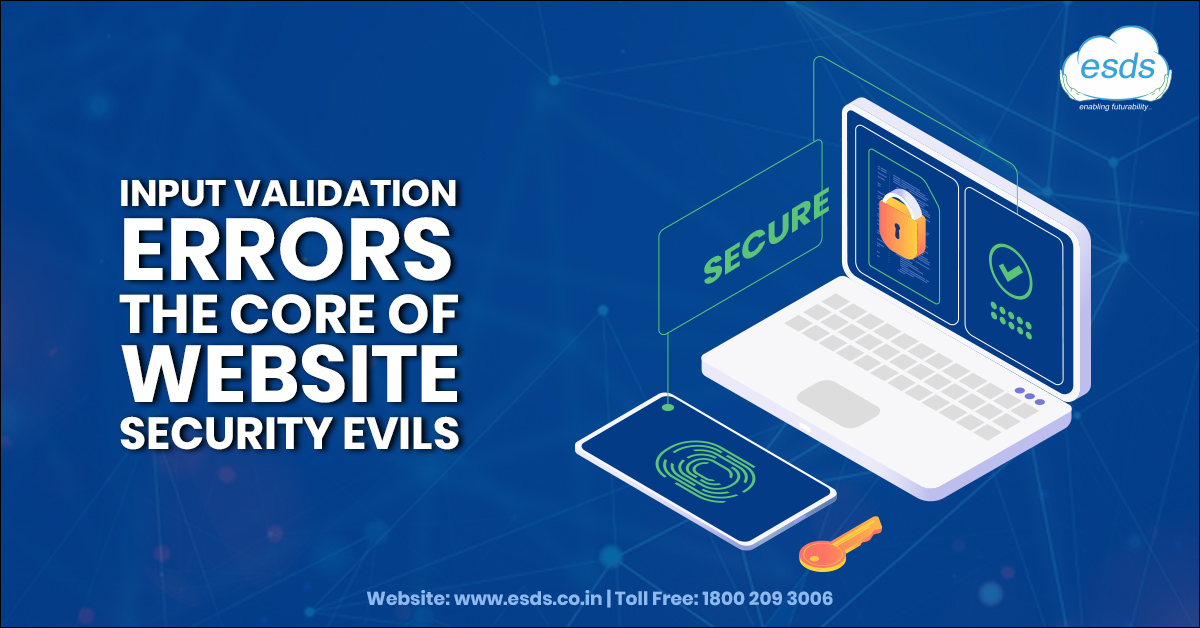Input Validation Errors: The Core of Website Security Evils
In the past few years with the rise of technological innovations, there has been an increase in the number and sophistication of security breaches. Poor input validation has turned out to be the root cause of these embarrassing data breaches reported in the last few years. While compiling the code, the developers create input fields for the users to enter whatever they wish. The website is secure until the unchecked input fields are not used for hacking.

Let’s see why input validation is crucial for website security
What Is Input Validation?
Websites processing input data from users or a wide range of systems should ensure that it is valid. Validation is carried on a variety of levels ranging from simply verifying the input types and lengths i.e. syntactic validation to ensuring the inserted values are valid in the application context i.e. semantic validation.
For websites, input validation is nothing but verifying the values inserted in the input field ensuring date, email address and other details inserted in the field are valid. This is the initial step for client-side validation performed directly in the browser and submitted values are verified on the server-side.
Input Validation is a commonly used method to check potentially dangerous inputs ensuring they are safe to be processed within the code.
Consequences of Improper Input Validation
Input validation reduces the attack surface minimizing the impact that tends to succeed. Improper input validation leads to incorrect results on the website or even crash. Insufficient input validation degrades the user experience on the website. If the registration form fails to detect the incorrect details entered on the form, the user won’t be able to confirm the account.
Also, there might be a circumstance where the invalid data clears the validation process on the browser side and is trapped during server validation. This process might take a longer duration to drive a response to the user.
How can we ensure Proper Input Validation?
Earlier, input fields were validated using the JavaScript either manually or with the help of a dedicated library. It’s better to look for the existing validation features rather than implementing validation since it is a tedious process. Languages and frameworks are consisting of built-in validators ensuring reliable and easier input validation.
- Blacklist and Whitelist Based Validation
Typically input validation for website security is carried out by blocking elements that can be used for an injection attack. Apostrophes and semicolons can be disabled to prevent SQL injection, parenthesis can be banned to stop a malicious user from inserting a JavaScript function. This is nothing but blacklisting elements and it is not advisable to use the technique. Blacklist-based validation is not feasible to implement since the developer can’t predict all the attack vectors which might help the hacker to bypass the validation.
Whitelist based validation can be used for well-defined input variables like numbers, dates, postcodes, etc. Whitelist based validation will help you to state the permitted values and reject the other input values. HTML5 format delivers a predefined whitelisting logic with built-in data type definitions where the inputs fields have predefined validations.
- HTML5 Validation
The HTML5 spec consists of built-in validation elements enabling you to specify the validation attributes directly in the HTML format. These attributes involve input fields like “required” specifying the required field, “type” for a data type, “maxlength” indicating the limit of the input, “pattern” defining a regex pattern for values that are valid. In addition, it includes CSS pseudo-classes like “:valid” for valid input and “:invalid” for incorrect input by the user. The HTML5 delivers standard HTML elements with just a few extra attributes ensuring content validation with cross-platform support.
- Input Validation against XSS
Input validation ensures the data entered in the input fields is not malicious. Though it minimizes the risk of attacks on the website, it should not be the defensive technique against cross-site scripting. Context-aware output encoding has turned out to be the crucial methodology against cross-site scripting. If the users enter apostrophe in the text field, there might be a reason to use the text and the website must be able to handle it throughout the lifecycle of data. Simply filtering inputs won’t help to prevent cross-site scripting and that is why modern web browsers have removed XSS filters.
Wrap Up
Input Validation ensures the text inserted in the input field is correct and does not belong to a malicious source. The improper input validation may lead to a security breach on a website resulting in the website being crashed. The input validation methods minimize the risk of attacks but are not the primary technique to prevent a security breach.
- Digital Transformation Paves the Way for the Finance Industry - July 29, 2021
- Embracing Change – How Banks are Adopting Digital Innovation - April 19, 2021
- How the Indian Education Sector is Embracing Cloud Computing - November 13, 2020
